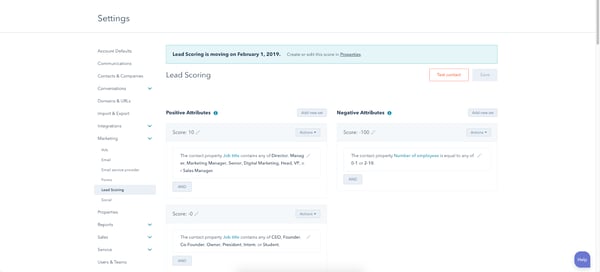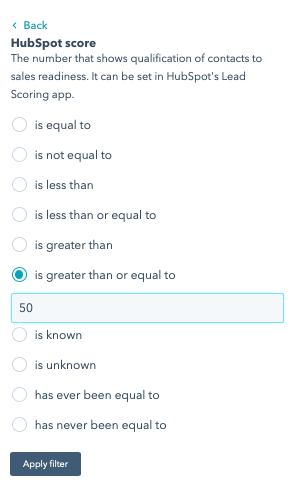Not all leads are created equal. . . I bet you've heard that before (from your sales team). It's true though.

Leads can enter your sales process at any stage.
You might see some leads are “hotter” or more qualified than others. These folks only need very little guidance to reach the end of your sales process.
However, more often than not, a lead will enter your sales process, and although they've handed over their contact information and started engaging with your brand — they're unqualified.
The reason could be:
- They aren't ready to purchase your product or service yet.
- Your product or service doesn't fit their needs well enough.
- Perhaps the time needed to convert them is just too lengthy.
Having your sales team pursue any of these leads is likely to cost you more in expense than you'd get back in return. There needs to be a way to filter the hot from the cold, right?
The solution is lead scoring.
So, don't waste any more of your time with leads that are bound to fail: Filter. Filter. FILTER!
Welcome to Part 3 of Lead Nurturing With HubSpot. Over the course of this series, you've discovered ways to grow your revenue, convert your leads, and delight your customers with lead nurturing powered by HubSpot.
What is Lead Scoring?
Let's make sure we're all on the same page about exactly what lead scoring is.
Lead scoring is a customizable, rule-based system for ranking leads to distinguish which ones are cold, lukewarm, or red hot, giving your marketing and sales teams a better idea of where to focus their efforts. Remember, hotter leads are close to converting, while colder ones require further lead nurturing or are unprepared/unqualified to make a purchase decision at the current time.
An automated lead scoring system takes not only the demographics (e.g., industry, job title, company size, gender), but the behavior of your prospects into account when generating their scores on (generally) a 0- to 100-point system. Behaviors can include everything from visiting your company's site, to opening an email, to filling out an online form. The challenge lies in determining the guidelines necessary for your personal model.
Why Does Lead Scoring Matter?
Why should you spend time scoring leads in HubSpot?
Well, you must know which leads to target. Succinctly, you can use lead scoring to create HubSpot active lists.
Segment types of contacts into different smart lists, like differing contacts who rank as MQLs versus SQLs.
Ultimately, you can create nurturing workflows that enroll the appropriate audiences using these active lists. Such as:
- MQL active lists assign MQLs to further nurturing before being passed off to sales.
- SQL active lists send SQLs and their behavioral and demographic information to sales to close a deal.
Lead scoring helps grow your revenue by identifying your most qualified audiences that haven't quite made it through your sales process and convert them.
Step 1: What Components Should My Lead Scoring Model Include?
When you're setting lead score values to determine a lead's quality, these numbers may be arbitrary; however, you're the ultimate decider about how much impact each lead score set has on the outcome of a lead's quality.
Let's break down what matters when scoring a lead's quality.
Implicit and explicit criteria
Distinguishing between these two kinds of criteria will provide a better understanding of your lead scoring system. Explicit scoring involves using the information directly shared by a lead to gauge their level of qualification — for instance, information provided on a landing page form by a site visitor.
Implicit scoring, on the other hand, is based on tracking the activity that drives a lead towards a sale to infer the lead's level of interest. In the modern marketing world, both the behavior and its tracking are primarily digital — typical tracked actions include most visited pages, emails opens, shared posts, and downloaded content.
By taking both implicit and explicit criteria into account, you can begin to visualize clearly what kind of leads your company is looking to focus on and which leads from the pool of candidates stand out.
Tiered behavioral scoring
The main function of a lead automation model is to assign varying degrees of importance to actions that your leads take. The best way to start organizing your criteria is by compiling a full list of relevant lead behavior across different categories, such as the following:
- Your website
- Email campaigns
- Info forms
- Downloadable content
- In-person events
- Webinars
- Direct interaction with company representatives
The next step is trickier — you need to rank the actions in each category by order of importance and assign them fitting point values. Is opening an email as significant as clicking through it on a link? Is visiting the home page of your company's site as important as approaching your booth at a trade show? Take time to think through the options to create a more effective and accurate scoring system.
Demographic scoring
Demographic lead qualification is based on the lead's identity rather than their behavior; while a static and thus less sophisticated element of your model, it's still essential and should not be overlooked. Relevant demographic criteria are details such as the following:
- Location (state, region, country, etc.)
- Industry
- Position
- Company size and type
- Revenue
- Age
- Gender
When deciding what effect a particular demographic feature will have on the lead's score, it can be helpful to consult your ideal buyer profile to understand the demographics of the person or business you would consider a good fit.
Negative scoring
How can you sort the good from the bad if there's no bad?
In all actuality, differentiating leads that are qualified or unqualified will help your team in their overall process. This helps eliminate any wasted time you might spend with unqualified leads. And you know, wasted time means wasted money.
Additionally, sorting unqualified from qualified leads can build a better coexisting relationship between your marketing and sales team, since they'll no longer waste their time, either.
Demographically, this could mean a lead isn't within your target audience, such that they're in the wrong industry or aren't decision-makers within their businesses.
Behaviorally, this could mean their actions indicate that they'd prefer not to interact with your brand, such as them moving your company's emails to spam or entering a personal email, not a company email, into a form's landing page.
Side note: sales and marketing cooperation
The goals of your marketing and sales teams must be aligned. Otherwise, leads could get lost in your sales process. Then, their buyer's journey might take them elsewhere — to a direct competitor!
Qualifying a lead with lead scoring is imperative to ensuring that this process is as smooth as possible. Again, you don't want to send “false” leads to your sales team for them to waste their time with.
So, a step that your company can take is to even let sales be part of the process for setting lead scoring values. They may have an objective opinion that isn't seen from a marketer's perspective. Use it!
Step 2: How to Set Up Lead Scoring in HubSpot
Let's get into the nitty-gritty of assigning and creating lead scoring values and attributes within your HubSpot account.
But first, there are two variations of lead scoring: Manual Lead Scoring and Predictive Lead Scoring.
Here, we'll only cover Manual Lead Scoring; however, Predictive Lead Scoring is great if you're a HubSpot Enterprise customer because it helps predict the likelihood a lead will close within the next 90 days by the use of learning algorithms and analysis of customer and industry sets.
In HubSpot, you can access your lead scoring tool under: Settings > Marketing > Lead Scoring.
To add a new lead score set, you must select the following variables:
- Property type: This could simply be a contact property or company property.
- The property: This could be a default property or a custom property.
- Action: This is whatever action the property is following.
- The action's variable: This could be the general action or specified outcome.
- Score: This is the positive, negative, or neutral value that you assign for the lead score set.
Let's walk through the steps of getting started with manual lead scoring:

Add a new lead score set:
- Set Positive Attributes → Add New Set → Assign Score and Action
- Set Negative Attributes → Add New Set → Assign Score and Action
Once you've set all your lead scoring criteria, you can test how a contact performs. Do this by navigating to the top-right corner and clicking Test contact.
Step 3: Determine Lead Score Thresholds and Segment With Active Lists
If you want to apply lead score values to more than one contact at a time, create active lists in HubSpot that use lead score thresholds.
What I mean is you can assign arbitrary values as part of active lists to rank contacts enrolled in them. For example, on a scale of 0 – 100:
- A visitor would be ranked 0.
- A prospect might be ranked 0 – 25.
- A MQL might be ranked 26 – 50.
- A SQL might be ranked 51 – 100.
By this manner, you're segmenting your database.
Now, to create your active list using lead score criteria, follow these steps:
- Navigate to Contacts > Lists.
- In the upper-right, click Create list.
- Choose Contact properties as your filter type.
- Then, search HubSpot score and attribute it any signifier and number that's appropriate for the audience you'd like to include in your lead nurturing workflow.
- If it's a workflow targeting MQLs to convert them into SQLs, you may want to select is greater than or equal to and enter a relative-to-your-business, sales-qualifying score.

Furthermore, if you want to attribute more criteria to a lead score active list, you can. Again, to target MQLs to convert them into SQLs, select Contact properties and set it to the Lifecycle stage | is not a customer. Or, perhaps, you want to target a specific industry. You can set Company property | is equal to | Tool manufacturer or a relevant industry that your business would nurture.
Step 4: Assigning Lead-Scored Active Lists to Nurturing Workflows
Use your newly created lead-scored active lists to target your most qualified leads. We've gone through a lot of the processes already. Now, it's all about putting the pieces together.
Sooo. . .
. . . Once you've assigned lead score sets and values. . .
. . . Once you've clarified and created active list thresholds. . .
You'll want to make sure that leads are assigned to appropriate workflows, or else the path they travel forward on may be wrong for them, and you could lose out on a potential customer.
The journey a lead goes on once scored must be actionable. It should be logical and follow suit of their previous actions.
So, if a contact's resulting score places them in:
- MQL active lists: Enroll them in further lead nurturing workflows to better qualify them before being sent to sales; or
- SQL active lists: Enroll them in sales-oriented workflows that familiarize them with your sales team (and vice-versa) and guide them towards the “closing” stage.
What Results Can I Expect?
You may remember the example of the B2B tech brand, PlanetTogether, that we helped increase their inbound flow of leads by 325%, shortening their sales cycle from 6 – 9 months to 3 months. Well, additionally, as part of the larger strategy to help their business, they segmented their audiences with lists and lead scoring to send their sales team automated lead notifications. This easily enabled their sales team to better service more leads with consultations and provide quicker response times.
Ultimately, this led to a 300% increase in PlanetTogether's total sales. What staunch growth!
Don't let the most qualified leads fall from your grasp. Use lead scoring to bolster your larger lead nurturing strategy by ensuring your buyer's journey is as frictionless as possible.
So. . . start on these steps:
- Clarify your campaign's goal.
- Make sure you have a way to collect a visitor's contact information.
- Have property values in place.
- Assign scores to leads.
- Create active lists.
- Enroll leads via active lists into targeted workflows.
And that ends Part 3 of the Lead Nurturing With HubSpot series. Here's what's next:
- Part 4: How to Test and Optimize Your Lead Nurturing Campaign
Stay tuned for the last part!
Want to connect with others on HubSpot tips, tricks, and updates? Head over to the HubSpot Community to join a conversation or start one of your own.










